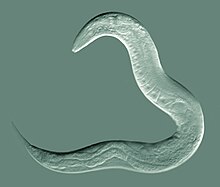Parasitic nematode
| Roundworms Temporal range: Precambrian–Recent |
|
|---|---|
 |
|
|
Caenorhabditis elegans, a model species of roundworm |
|
| Scientific classification | |
| Kingdom: | Animalia |
| Clade: | Nematoida |
| Phylum: |
Nematoda Diesing, 1861 |
| Classes | |
|
(see text) |
|
| Synonyms | |
|
|
(see text)
The nematodes (/ˈnɛmətoʊdz/) or roundworms constitute the phylum Nematoda. They are a diverse animal phylum inhabiting a broad range of environments. Nematode species can be difficult to distinguish, and although over 25,000 have been described, of which more than half are parasitic, the total number of nematode species has been estimated to be about 1 million. Nematodes are classified along with insects and other moulting animals in the clade Ecdysozoa, and, unlike flatworms, have tubular digestive systems with openings at both ends.
Nematodes have successfully adapted to nearly every ecosystem from marine (salt water) to fresh water, to soils, and from the polar regions to the tropics, as well as the highest to the lowest of elevations. They are ubiquitous in freshwater, marine, and terrestrial environments, where they often outnumber other animals in both individual and species counts, and are found in locations as diverse as mountains, deserts and oceanic trenches. They are found in every part of the earth's lithosphere, even at great depths (0.9–3.6 km) below the surface of the Earth in gold mines in South Africa. They represent 90% of all animals on the ocean floor. Their numerical dominance, often exceeding a million individuals per square meter and accounting for about 80% of all individual animals on earth, their diversity of life cycles, and their presence at various trophic levels point at an important role in many ecosystems. The many parasitic forms include pathogens in most plants and animals (including humans). Some nematodes can undergo cryptobiosis.
...
Wikipedia
